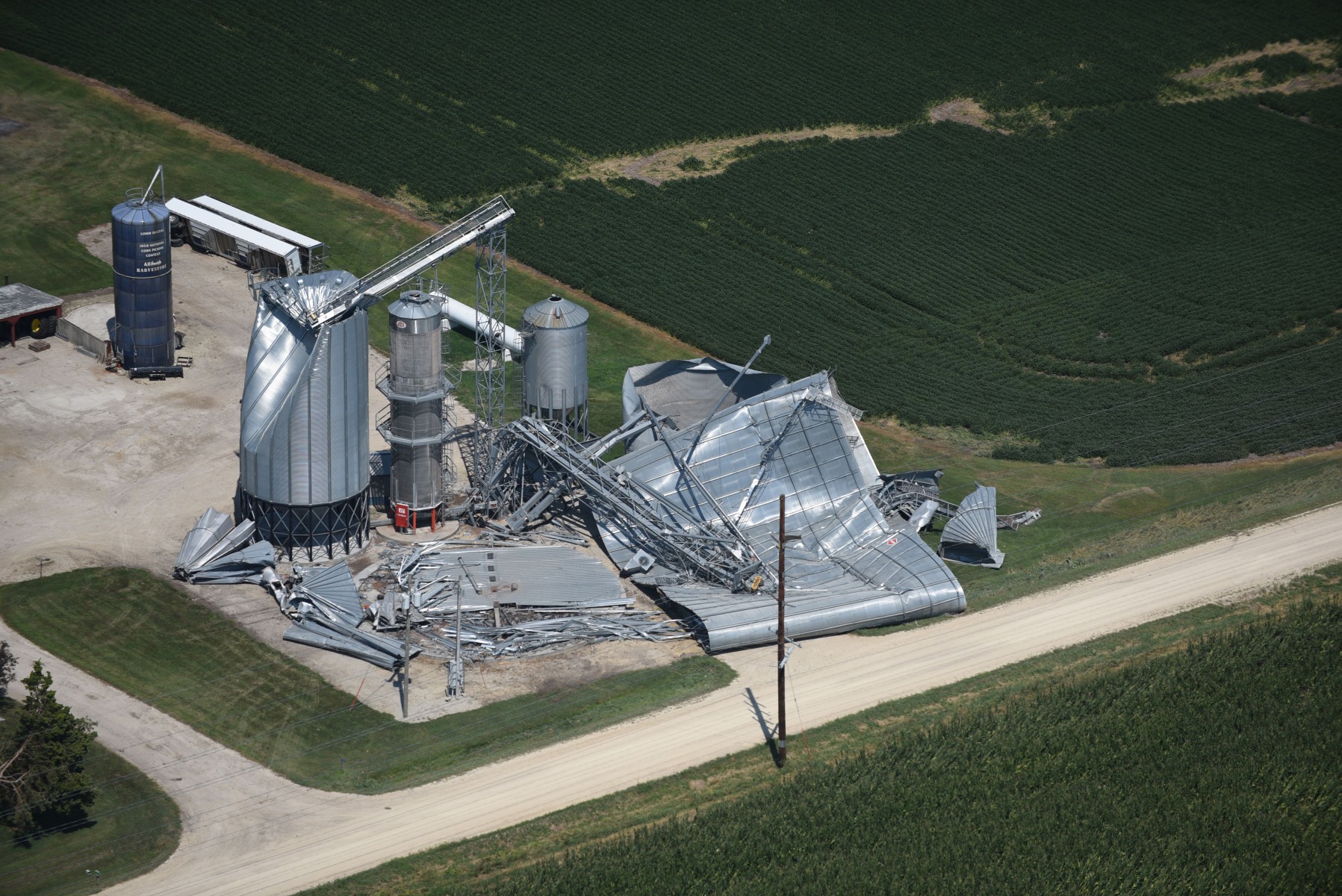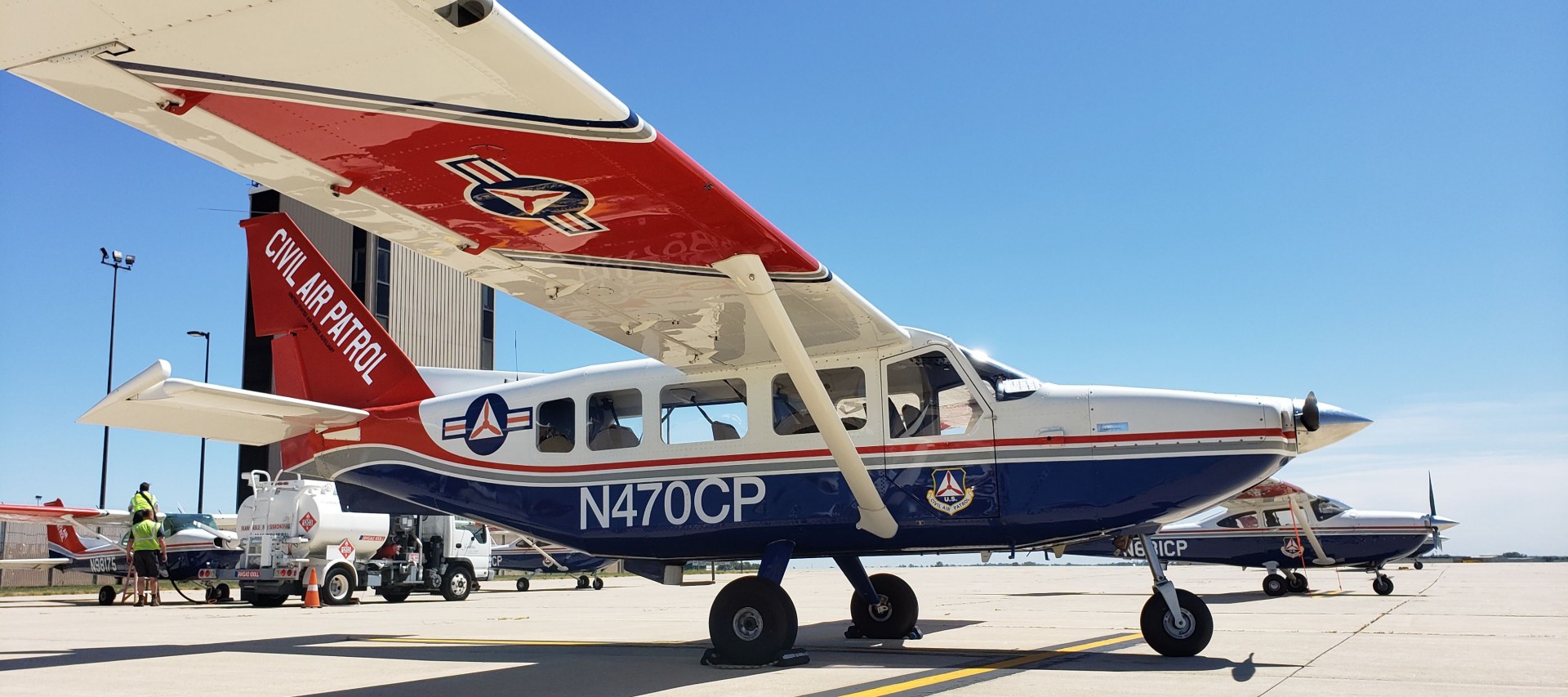'Midwest Miracle': Iowa Wing, CAP Neighbors Quickly Provide Derecho Damage Aerial Images
Paul South
Contributing Writer
 Downed power lines and stacks of splintered tree limbs lined both sides of the street in Maj. Ron Mutchler’s suburban neighborhood in Des Moines, nearly two weeks after a derecho — powerful, out-of-nowhere straight-line winds — sucker-punched the Midwest, slashing a swath of destruction 40 miles wide across 770 miles in just 12 hours.
Downed power lines and stacks of splintered tree limbs lined both sides of the street in Maj. Ron Mutchler’s suburban neighborhood in Des Moines, nearly two weeks after a derecho — powerful, out-of-nowhere straight-line winds — sucker-punched the Midwest, slashing a swath of destruction 40 miles wide across 770 miles in just 12 hours.
“It looks like a war zone,” Mutchler said as he drove his truck through the battered Iowa countryside.
So it is for much of Iowa and surrounding states from Indiana to Kansas. The derecho — Spanish for “straight” — mauled the region with little warning Aug. 10-11, with steady winds the force of a Category 2 hurricane and reports of up to 140 mph gusts near Cedar Rapids – the equivalent of a Category 4 hurricane. In Marshalltown, Iowa, winds officially registered 112 mph.
Many Midwesterners were caught off-guard. Homes were shredded.
But 23 hours after the storm steamed through America’s heartland, the Iowa Wing — four aircraft strong — and surrounding Civil Air Patrol wings delivered aerial images of storm damage to local, state and federal emergency management and homeland security agencies. The rapid turnaround helped secure a presidential disaster area declaration.
Mutchler, the Iowa Wing’s emergency services officer, saw the CAP response in near-supernatural terms: “It’s almost like a miracle,” he said. “There’s no other way to describe it.”
Some 35 CAP members, many without power and still picking up the pieces of their own homes, immediately went to work upon request Aug. 14 with only an hour’s notice.
Over the next 36 hours, aircrews from the Iowa, Illinois and Kansas wings made 37 flights and gathered 3,500 aerial photographs of derecho damage.
On the ground, members like 1st Lt. Jim Spielman, commander of the Cedar Rapids Composite Squadron, coordinated the response, even with his own Marion home damaged and electricity disrupted. The squadron’s safety officer and past commander, Capt. Randi Blair, suffered severe damage to her home, the result of large downed trees and wind damage.
But Blair – whom Spielman described as the mom of the squadron – still delivered aerial images to emergency management officials.
“It was really awesome. Members, cadets and their families, they all went over to her house, the day after the storm. And they were all cleaning it up and helping in any way they could to help her out,” Spielman said. “It’s almost like a big family. Everybody’s going to try to help everybody out.”
Power returned for the Cedar Rapids unit’s last affected member Aug. 20, 2½ weeks after the storm.
On the ground, CAP cadets ventured into neighborhoods to help with storm cleanup. Other members delivered ice, food, water, generators and other support to residents in their areas.
“The thing that I really love is these cadets, these kids — on their own — have taken it upon themselves to go out and just help whoever the can and clear branches and trees and they’re just going out and doing it,” Spielman said.
Col. Jonathan Lartigue, Iowa Wing commander, is a New Orleans native who helped his family sift through the rubble of 2005’s Hurricane Katrina. He’s also been part of CAP relief efforts in a number of named storms.
“I can tell you this thing looks exactly like a Category 2, Category 3 landfall, with the exception that there’s not a deluge of water lying around everywhere,” Lartigue said
But while hurricanes offer days of advance warning, residents had only minutes to prepare as the derecho rolled west at over 70 mph. Lartigue, who lives in the Cedar Rapids suburb of Robins, had 60 minutes, thanks to warnings from CAP members in Des Moines.
“I can’t imagine what people who aren’t used to winds of that magnitude did,” Lartigue said. “Most people didn’t know it was coming. And when the sirens went off, it was barely 15 minutes before it hit.“They probably didn’t know what it was all about. I feel very sorry for the people who didn’t have any warning at al. ... It was an absolute mess.”
In the midst of a disaster, pilots, ground and support personnel stepped up.
“I think those of us who volunteer in Civil Air Patrol do so out of a desire to serve our communities and serve our country,” Lartigue said. “And those of us who are involved in emergency services take that a step further, to serve our communities in times of need.
“And it’s especially difficult to step up and provide that service, when you and your loved ones are also among those who are in need. So, it takes a special kind of person to prepare to help your community when a disaster occurs, knowing that you may be one of the people who was impacted by this disaster,” he said.
“Family comes first,” Lartigue said. “But we’re also ready when asked to do what’s necessary to help other families as well.”
His wing couldn’t have met the mission mandate without help from its CAP neighbors, he added.
“It’s wonderful that we are able to call on our neighboring wings when we need assistance to operate together as one unified Civil Air Patrol to meet the needs of our customers,” Lartigue said.
Maj. Gen. Mark Smith, CAP national commander, praised the rapid response,..
In a note to Lartigue, Smith wrote: “My compliments to you, your team and members from adjacent wings who came to help in such an outstanding manner during difficult circumstances.”




